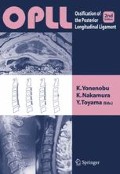Conclusions
In this series of cervicothoracic OPLL patients who underwent PECTL, the postoperative mean recovery rate of the JOA score was 44.9%. Postoperative sagittal alignment was preserved in all but one patient, who underwent simultaneous laminectomy in the lower thoracic spine. PECTL obtains decompression by a posterior shift of the whole spinal cord after simultaneous spinal canal enlargement, sparing the spinal cord from iatrogenic injury. This method has a low rate of postoperative paralysis and complications and can therefore be recommended.
Access this chapter
Tax calculation will be finalised at checkout
Purchases are for personal use only
Preview
Unable to display preview. Download preview PDF.
References
Tsuzuki N, Wadano Y, Kikuchi S (1997) Extensive cervicothoracic laminoplastic decompression for thoracic myelopathy caused by ossification of the posterior longitudinal ligament. In: Yonenobu K, Sakou T, Ono K (eds) OPLL, ossification of the posterior longitudinal ligament. Springer, Tokyo, pp 185–192
Seki S, Kikuchi S (1995) Short-term outcome of the extensive cervicothoracic laminoplastic decompression for the cervical and thoracic myelopathy due to OPLL (in Japanese). J Jpn Spine Res Soc 6:45
Yoshida M, Otani K, Shibasaki K, Ueda S (1992) Expansive laminoplasty with reattachment of spinous process and extensor musculature for cervical myelopathy. Spine 17:491–497
Yoshida M, Tamaki T, Kawakami M, Nakatani N, Ando M, Yamada H, Hayashi N (2002) Does reconstruction of posterior ligamentous complex with extensor musculature decrease axial symptom after cervical laminoplasty? Spine 27:1414–1418
Abumi K, Kaneda K, Satoh S, Hasegawa K (1996) Anterior decompression and spinal reconstruction through posterior approach for ossification of the thoracic posterior longitudinal ligament (in Japanese). Rinsho Seikei Geka 31:563–569
Fujimura S, Nishi Y, Toyama Y, Suzuki N (1996) Anterior decompression and fusion for ossification of the posterior longitudinal ligament of the upper thoracic spine causing myelopathy: using the manubrium splitting approach. Spinal Cord 34:387–393
Ohtani K, Nakai S, Fujimura S, Manzoku S, Shibasaki K (1982) Anterior surgical decompression for thoracic myelopathy as a result of ossification of the posterior longitudinal ligament. Clin Orthop 166:82–88
Hanai K, Ogikubo O, Miyashita T (2002) Anterior decompression for myelopathy resulting from thoracic ossification of posterior longitudinal ligament. Spine 27:1070–1076
Ohtsuka K, Terayama K, Wada M, Kinoshita H, Takahashi S, Murata S (1988) The results of surgical treatment for thoracic myelopathy due to ossification of posterior longitudinal ligament: anterior decompression of the thoracic cord through the posterior approach (in Japanese). Rinsho Seikei Geka 23:467–472
Tomita K, Kawahara N, Baba H, Kikuchi Y, Nishimura H (1990) Circumferential decompression for thoracic myelopathy due to combined ossification of posterior longitudinal ligament and ligamentum flavum. Spine 15:1114–1120
Yonenobu K, Ebara S, Fujiwara K, Fujiwara K, Yamashita K, Ono K, Yamamuro T, Harada N, Ogino H, Ojima S (1987) Thoracic myelopathy secondary to ossification of posterior longitudinal ligament. J Neurosurg 66:511–518
Yonenobu K, Korkusuz F, Hososno N, Ebara S, Ono K (1990) Lateral rhachotomy for thoracic spinal lesions. Spine 15:1121–1125
Tsuzuki N, Hirabayashi S, Abe R (2001) Staged spinal cord decompression through posterior approach for thoracic myelopathy caused by ossification of posterior longitudinal ligament. Spine 26:1623–1630
Yamasaki M (2002) Posterior decompression and fusion for thoracic myelopathy due to ossification of posterior longitudinal ligament of the spine (in Japanese). Spine & spinal cord (in Japanese) 15:98–103
Author information
Authors and Affiliations
Editor information
Editors and Affiliations
Rights and permissions
Copyright information
© 2006 Springer
About this chapter
Cite this chapter
Nakagawa, Y., Yoshida, M. (2006). Posterior Extensive Cervicothoracic Laminoplasty. In: Yonenobu, K., Nakamura, K., Toyama, Y. (eds) OPLL. Springer, Tokyo. https://doi.org/10.1007/978-4-431-32563-5_34
Download citation
DOI: https://doi.org/10.1007/978-4-431-32563-5_34
Publisher Name: Springer, Tokyo
Print ISBN: 978-4-431-32561-1
Online ISBN: 978-4-431-32563-5
eBook Packages: MedicineMedicine (R0)

